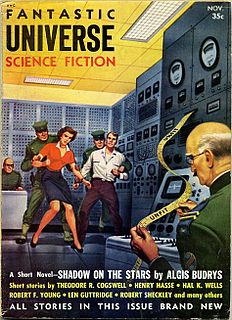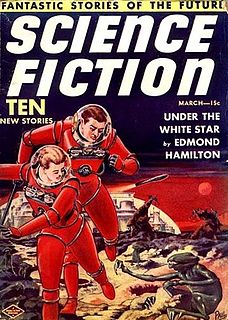
James Benjamin Blish was an American science fiction and fantasy writer. He is best known for his Cities in Flight novels, and his series of Star Trek novelizations written with his wife, J. A. Lawrence. He is credited with creating the term "gas giant" to refer to large planetary bodies.

William Cuthbert Faulkner was an American writer known for his novels and short stories set in the fictional Yoknapatawpha County, based on Lafayette County, Mississippi, where Faulkner spent most of his life. A Nobel Prize laureate, Faulkner is one of the most celebrated writers of American literature and is widely considered the greatest writer of Southern literature.

Nelson Algren was an American writer. His 1949 novel The Man with the Golden Arm won the National Book Award and was adapted as the 1955 film of the same name.

Margaret St. Clair was an American fantasy and science fiction writer, who also wrote under the pseudonyms Idris Seabright and Wilton Hazzard.

Edmund Hodgson Yates was a British journalist, novelist and dramatist.

Karen Joy Fowler is an American author of science fiction, fantasy, and literary fiction. Her work often centers on the nineteenth century, the lives of women, and alienation.
Ray Russell was an American editor and writer of short stories, novels, and screenplays. Russell is best known for his horror fiction, although he also wrote mystery and science fiction stories.

The Man with the Golden Arm is a novel by Nelson Algren, published by Doubleday in November 1949. One of the seminal novels of post-World War II American letters, The Man with the Golden Arm is widely considered Algren's greatest and most enduring work. It won the National Book Award in 1950.

Imagination was an American fantasy and science fiction magazine first published in October 1950 by Raymond Palmer's Clark Publishing Company. The magazine was sold almost immediately to Greenleaf Publishing Company, owned by William Hamling, who published and edited it from the third issue, February 1951, for the rest of the magazine's life. Hamling launched a sister magazine, Imaginative Tales, in 1954; both ceased publication at the end of 1958 in the aftermath of major changes in US magazine distribution due to the liquidation of American News Company.

Art Shay was an American photographer and writer.

Fantastic Adventures was an American pulp fantasy and science fiction magazine, published from 1939 to 1953 by Ziff-Davis. It was initially edited by Raymond A. Palmer, who was also the editor of Amazing Stories, Ziff-Davis's other science fiction title. The first nine issues were in bedsheet format, but in June 1940 the magazine switched to a standard pulp size. It was almost cancelled at the end of 1940, but the October 1940 issue enjoyed unexpectedly good sales, helped by a strong cover by J. Allen St. John for Robert Moore Williams' Jongor of Lost Land. By May 1941 the magazine was on a regular monthly schedule. Historians of science fiction consider that Palmer was unable to maintain a consistently high standard of fiction, but Fantastic Adventures soon developed a reputation for light-hearted and whimsical stories. Much of the material was written by a small group of writers under both their own names and house names. The cover art, like those of many other pulps of the era, focused on beautiful women in melodramatic action scenes. One regular cover artist was H.W. McCauley, whose glamorous "MacGirl" covers were popular with the readers, though the emphasis on depictions of attractive and often partly clothed women did draw some objections.

Fantastic Universe was a U.S. science fiction magazine which began publishing in the 1950s. It ran for 69 issues, from June 1953 to March 1960, under two different publishers. It was part of the explosion of science fiction magazine publishing in the 1950s in the United States, and was moderately successful, outlasting almost all of its competitors. The main editors were Leo Margulies (1954–1956) and Hans Stefan Santesson (1956–1960); under Santesson's tenure the quality declined somewhat, and the magazine became known for printing much UFO-related material. A collection of stories from the magazine, edited by Santesson, appeared in 1960 from Prentice-Hall, titled The Fantastic Universe Omnibus.
John Faulkner was an American author. His works, in a plain style, depict life in Mississippi. Faulkner is best-remembered for the novels Men Working (1941) and Dollar Cotton (1942), and the memoir, My Brother Bill: An Affectionate Reminiscence (1963), about his elder sibling, author William Faulkner.

Chicago literature is writing, primarily by writers born or living in Chicago, that reflects the culture of the city.

Future Science Fiction and Science Fiction Stories were two American science fiction magazines that were published under various names between 1939 and 1943 and again from 1950 to 1960. Both publications were edited by Charles Hornig for the first few issues; Robert W. Lowndes took over in late 1941 and remained editor until the end. The initial launch of the magazines came as part of a boom in science fiction pulp magazine publishing at the end of the 1930s. In 1941 the two magazines were combined into one, titled Future Fiction combined with Science Fiction, but in 1943 wartime paper shortages ended the magazine's run, as Louis Silberkleit, the publisher, decided to focus his resources on his mystery and western magazine titles. In 1950, with the market improving again, Silberkleit relaunched Future Fiction, still in the pulp format. In the mid-1950s he also relaunched Science Fiction, this time under the title Science Fiction Stories. Silberkleit kept both magazines on very slim budgets throughout the 1950s. In 1960 both titles ceased publication when their distributor suddenly dropped all of Silberkleit's titles.

Tiger was an American men's magazine that featured photographs of pin-up girls as well as journalism and fiction. It was founded in Chicago in 1956 by G. George Fox, Jr. and published by Reynard Press into the mid-1960s. The first issue was Vol. 1 No. 1 dated May 1956.

Marvel Science Stories was an American pulp magazine that ran for a total of fifteen issues in two separate runs, both edited by Robert O. Erisman. The publisher for the first run was Postal Publications, and the second run was published by Western Publishing; both companies were owned by Abraham and Martin Goodman. The first issue was dated August 1938, and carried stories with more sexual content than was usual for the genre, including several stories by Henry Kuttner, under his own name and also under pseudonyms. Reaction was generally negative, with one reader referring to Kuttner's story "The Time Trap" as "trash". This was the first of several titles featuring the word "Marvel", and Marvel Comics came from the same stable in the following year.

10 Story Fantasy was a science fiction and fantasy pulp magazine which was launched in 1951. The market for pulp magazines was already declining by that time, and the magazine only lasted a single issue. The stories were of generally good quality, and included work by many well-known writers, such as John Wyndham, A.E. van Vogt and Fritz Leiber. The most famous story it published was Arthur C. Clarke's "Sentinel from Eternity", which later became part of the basis of the movie 2001: A Space Odyssey.

Viet Thanh Nguyen is a Vietnamese-American professor and novelist. He is the Aerol Arnold Chair of English and Professor of English and American Studies and Ethnicity at the University of Southern California.

Jessie Fremont O'Donnell was a 19th-century American writer of poems, novels and magazine articles, as well as a lecturer. In December, 1887, her first book, Heart Lyrics appeared. Later books were Love Poems of Three Centuries, Three Centuries of English Love-Songs, A Soul from Pudge's Corners, and others, besides contributions to various U.S. periodicals. She also wrote essays, short stories, and character studies.


















